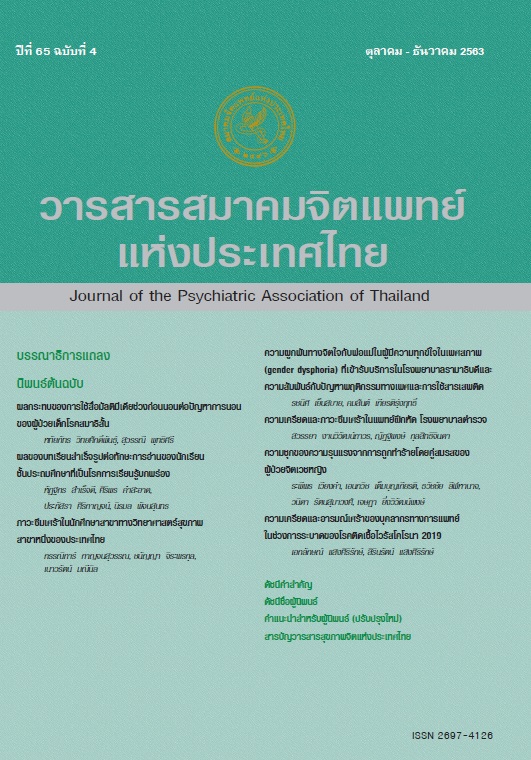Effects of programed instruction on reading skill among primary school students with learning disorder.
Main Article Content
Abstract
Abstract
Object: To compare reading and depression scores before and after completing session 4 and 8 of programed instruction training among primary school students.
Method: This research is a quasi-experiment. There were 23 volunteers who aged 7 years to 11 years were diagnosed with learning disorder by psychiatrists. All children were trained to read by using programed instruction. Each person was trained every 2 weeks with 8 sessions and for 30-40 minutes per session. Score of reading skill and depression were assessed by Wide Range Achievement Test – Thai version and Children's Depression Inventory, respectively. Assessments were performed before and after completing session 4 and 8. A repeated measure ANOVA was used to analyse.
Results: Mean score of accuracy in reading between before, after completing session 4 and 8 of training were statistically significant difference (p-value <0.001), including reading fluency (p-value <0.001) and depression (p-value = 0.049).
Conclusion: The program instruction helps children with learning disorder to greatly improve accuracy in reading but slightly for reading fluency and depression.
Article Details
Articles submitted for consideration must not have been previously published or accepted for publication in any other journal, and must not be under review by any other journal.
References
1. Chaisudomsom K, Phahonphak P, Wattanawikit P, Phahonphak P. Citwechṣ̄ās̄tr̒ Psychiatry.
Nana Witthaya Printing House; 2559.
2. Association AP. Diagnostic and statistical manual of mental disorders (DSM-5®). American Psychiatric Pub; 2013.
3. Maughan B, Rowe R, Loeber R, Stouthamer-Loeber M. Reading problems and depressed mood. J Abnorm Child Psychol. 2003;31(2):219–29.
4. Görker I. The Prevalence and Gender Differences in Specific Learning Disorder. In: Learning Disabilities. IntechOpen; 2019.
5. Patjanasoontorn N, Singkhorn-ard J, Unphrai P, Srisawat W, Udomsin C, Kittisiriwattanakul O. Learning and Behavioral problems in a Demonstration school children , Education level 1 ( Grade 1-3 ) in Khon Kaen Province. J Psychiatr Assoc Thail. 2011;56(4):345–51.
6. Piyasil V, Wangtan S. Learning Disorders and Comorbidity. J Psychiatr Assoc Thail. 2015;60(4):287–96.
7. Panturee W, Prachanban, Chamnan Panawong P. The Development of Individualized Education Program (IEP) for Students with Learning Disability (LD) Primary Level. Soc Sci Res Acad J. 2556;8(Ld):135–49.
8. Charach A, Fernandez R. Enhancing ADHD medication adherence: challenges and opportunities. Curr Psychiatry Rep. 2013;15(7):371.
9. Khammanee T. 14Wiṭhī s̄xn s̄ảh̄rạb khrū mụ̄x xāchīph. 11th ed. Bangkok: Chulalongkorn University Press; 2555. 99-104 p.
10. Arayawinu P. R I T Krabwnkār s̄xn næw h̄ım̀ (RtI: Response to Instruction). Nakhon Pathom: I.Q.
Book center; 2554.
11. Mercer CD, Campbell KU, Miller MD, Mercer KD, Lane HB. Effects of a reading fluency intervention for middle schoolers with specific learning disabilities. Learn Disabil Res Pract. 2000;15(4):179–89.
12. Scammacca NK, Roberts G, Vaughn S, Stuebing KK. A Meta-Analysis of Interventions for Struggling Readers in Grades 4-12: 1980-2011. J Learn Disabil [Internet]. 2013/10/03. 2015 Jul;48(4):369–90. Available from: https://www.ncbi.nlm.nih.gov/pubmed/24092916
13. Kaewkangwan C, Singhasiwanon P. Tảrā kār wicạy thāng khlinik. Bangkok: Amarin Printing & Publishing Public Co., Ltd.; 2554.
14. Orme DR, Johnstone B, Hanks R, Novack T. The WRAT-3 Reading Subtest as a Measure of Premorbid Intelligence Among Persons With Brain Injury. Rehabil Psychol. 2004;49(3):250.
15. Wiphawee S, Pranduangduen S, Panichsudarat S. Peid mum mxng WRAT-Thai. Journal of Clinical Psychology. 2556;44:1–4.
16. Trangkasombat U, Likanapichitkul D. The Children’s Depression Inventory as a screen for depression in Thai children. J Med Assoc Thai. 1997 Aug;80(8):491–9.
17. Armstrong RA. Recommendations for analysis of repeated‐measures designs: testing and correcting for sphericity and use of manova and mixed model analysis. Ophthalmic Physiol Opt. 2017;37(5):585–93.
18. Songkram N. Kār xxkbæb læa phạtʹhnā mạltimīdeīy pheụ̄̀x kār reīyn rū̂ (MULTIMEDIA FOR LEAMING: DESIGN & DEVELOPMENT). 3rd ed. Bangkok: Publisher of Chulalongkorn University; 2557.
19. Kruakeaw P, Areepong A, Udom P. The Development of Programmed Lessons on Rhetorical Writing for Prathomsuksa 6 Students. Princess Naradhiwas Univ J Humanit Soc Sci. 2018;1:1–10.
20. Honhuan K. The development of programmed instruction on Thai words formation for matthayomsuksa 1 students. Naresuan University; 2010.
21. Yimthanom U. The development of programmed instruction on word compounding in Thai language for matthayomsuksa 3 students. Silpakorn University; 2010. p. 74.
22. Boden A, Archwamety T, McFarland M. Programmed Instruction in Secondary Education: A Meta-Analysis of the Impact of Class Size on Its Effectiveness. 2000;
23. Thanasirikun, A. Effects of using Thai word spelling applications with learning center instruction on Thai word spelling abilities of first grades with reading difficulties. Chulalongkorn University; 2016.
24. Lengjeh A, Chewpattanakul P, Benkarn P. A study of reading ability of students with learning disabilities using rhymes. Research and Special Education Journal. 2560;2:51–64.
25. Hasbrouck J, Glaser DR. Reading fluency: Understanding and teaching this complex skill. Austin, TX: Gibson Hasbrouck & Associates; 2012.
26. Brent DA, Maalouf FT. Pediatric depression: is there evidence to improve evidence‐based treatments? J Child Psychol Psychiatry. 2009;50(1‐2):143–52.


